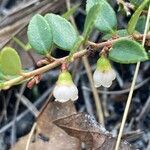An evergreen shrub. It is a low shrub that forms roots as it spreads. It grows 40 cm high and spreads 90 cm wide. The leaves are small and thick and leathery. They are 8-20 mm long and 3-10 mm wide. They have fine teeth along the edge. The flowers are very small and white with pink marks. They are in small clusters. The flowers are urn shaped. The fruit is purple-black. They are 1.2 cm across.
Roots woody, tuberous-thickened at intervals; stems trailing, to 1 m; lvs leathery, evergreen, elliptic, 5–15 mm, glabrous, remotely serrulate, much-thickened at the margin; fls in small lateral clusters much shorter than the subtending lvs; cor pink, 4 mm; fr purple-black; 2n=24. Pine-barrens and pocosins; se. Va. to S.C. and adj. Ga. Apr., May. (Herpothamnus c.)

